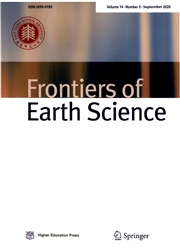Variabilities of carbonateδ13C signal in response to the late Paleozoic glaciations,Long’an,South China
作者:Bing YANG,Xionghua ZHANG,Wenkun QIE,Yi WEI,Xing HUANG,Haodong XIA
摘要:An integrated study of biostratigraphy,microfacies,and stable carbon isotope stratigraphy was carried out on the late Famennian–early Asselian carbonates of the Long’an section in Guangxi,South China.Stable carbon isotope studies in the Long’an section have revealed four major positive shifts ofδ13C values in the Carboniferous strata in South China.The first shift occurred in the Siphonodella dasaibaensia zone in the Tournaisian,with an amplitude of 4.19‰.The second shift occurred near the Visean/Serpukhovian boundary,with an amplitude of 2.63‰.The third shift occurred in the Serpukhovian,with an amplitude of 3.95‰.The fourth shift occurred in the Kasimovian,with an amplitude of 3.69‰.Furthermore,there were several brief positiveδ13C shifts during the late Famennian to early Tournaisian.All of these shifts can be well correlated globally,and each corresponds to sea-level regressions in South China and Euro-America,indicating increases in ocean primary productivity and global cooling events.Chronologically,the four major positive excursions ofδ13C,together with several brief positiveδ13C shifts that were observed during the late Famennian to the early Tournaisian,correspond to the well-accepted Glacial I,II,and III events.
发文机构:Faculty of Earth Sciences Cores and Samples Centre of Natural Resources State Key Laboratory of Palaeobiology and Stratigraphy School of Safety Engineering
关键词:carbonisotopesLatePaleozoicIceAgeCARBONIFEROUSsea-levelchangesglobalclimatevariation
分类号: P53[天文地球—古生物学与地层学]
- Spatiotemporal influences of land use/cover changes on the heat island effect in rapid urbanization area
- A simplified index to assess the combined impact of tropical cyclone precipitation and wind on China
- Land use and land cover classification using Chinese GF-2 multispectral data in a region of the North China Plain
- Erosion-deposition patterns and depo-center movements in branching channels at the near-estuary reach of the Yangtze River
- Metal accumulation in Asiatic clam from the Lower Min River (China) and implications for human health
- Estimation of copper concentration of rocks using hyperspectral technology
- Chemical and minero-petrographical changes on granulite rocks affected by weathering processes
- BMA probability quantitative precipitation forecasting of land-falling typhoons in south-east China
- Accumulation of unconventional petroleum resources and their coexistence characteristics in Chang7 shale formations of Ordos Basin in central China
- Improvement of typhoon rainfall prediction based on optimization of the Kain-Fritsch convection parameterization scheme using a micro-genetic algorithm


